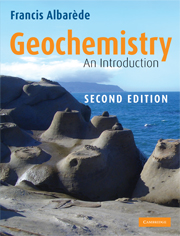Book contents
- Frontmatter
- Contents
- Preface to the second edition
- Foreword to the first English edition
- Foreword to the French edition
- Acknowledgments
- Introduction
- 1 The properties of elements
- 2 Mass conservation and elemental fractionation
- 3 Fractionation of stable isotopes
- 4 Geochronology and radiogenic tracers
- 5 Element transport
- 6 Geochemical systems
- 7 The chemistry of natural waters
- 8 Biogeochemistry
- 9 Environments
- 10 Mineral reactions
- 11 The solid Earth
- 12 The Earth in the Solar System
- 13 The element barn
- Appendix A Composition of the major geological units
- Appendix B The mixing equation for ratios
- Appendix C A refresher on thermodynamics
- Appendix D The geological time scale
- Appendix E An overview of analytical methods
- Appendix F Physical and geophysical constants
- Appendix G Some equations relative to residence time
- Appendix H The adiabatic atmosphere
- Further reading
- Index
12 - The Earth in the Solar System
Published online by Cambridge University Press: 05 June 2013
- Frontmatter
- Contents
- Preface to the second edition
- Foreword to the first English edition
- Foreword to the French edition
- Acknowledgments
- Introduction
- 1 The properties of elements
- 2 Mass conservation and elemental fractionation
- 3 Fractionation of stable isotopes
- 4 Geochronology and radiogenic tracers
- 5 Element transport
- 6 Geochemical systems
- 7 The chemistry of natural waters
- 8 Biogeochemistry
- 9 Environments
- 10 Mineral reactions
- 11 The solid Earth
- 12 The Earth in the Solar System
- 13 The element barn
- Appendix A Composition of the major geological units
- Appendix B The mixing equation for ratios
- Appendix C A refresher on thermodynamics
- Appendix D The geological time scale
- Appendix E An overview of analytical methods
- Appendix F Physical and geophysical constants
- Appendix G Some equations relative to residence time
- Appendix H The adiabatic atmosphere
- Further reading
- Index
Summary
The Earth is, together with Mercury, Venus, and Mars, one of the rocky planets of the inner Solar System. Our sampling of the Solar System is rather limited. Terrestrial samples are plentiful and the Apollo astronauts brought back hundreds of kilograms of lunar rocks. More than 30 meteorites from the Moon and 40 meteorites from Mars (the SNC meteorites) complete the well-identified planetary material. Achondrites are basaltic rocks which have been suggested to come from the asteroid Vesta in the asteroid belt, between Mars and Jupiter. Chondrites derive their name from the presence of abundant mm-sized molten blebs known as chondrules. They are fragments of much smaller, undifferentiated asteroids, and are divided into carbonaceous, ordinary, and enstatite meteorites. Carbonaceous meteorites are remarkable because they contain hydrous minerals, organic matter, refractory inclusions, and pre-solar grains (SiC, diamonds). Iron meteorites are actually Fe–Ni alloys: some of them represent the core of some small planetary bodies disrupted by impacts.
The composition and the conditions prevailing at the surface of each rocky planet are very different and distinct from those of the giant gas-rich planets, such as Jupiter and Saturn, of the outer Solar System. Astronomical observations indicate that the Sun and its companion planets formed by condensation of a cloud of gas and dust, called the solar nebula. The topic of this chapter is to describe the major processes that led from the early stages of the Universe to the formation of the elements, to the birth of the Solar System and finally to the formation of the Earth and its sister planets.
- Type
- Chapter
- Information
- GeochemistryAn Introduction, pp. 248 - 287Publisher: Cambridge University PressPrint publication year: 2009

